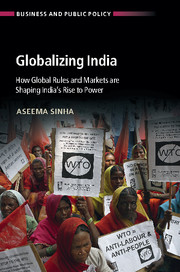Book contents
- Frontmatter
- Dedication
- Contents
- List of figures
- List of tables
- Preface and acknowledgments
- Note on currency translation
- List of abbreviations
- 1 How global rules and markets are shaping India's rise to power
- 2 A theory of causal mechanisms and Global Design-in-Motion
- 3 Trade, statecraft, and state capacity in India
- 4 Realigning interests toward global reach: Changes in India's pharmaceutical sector
- 5 Mobilizing new interests and tying the state's hands: Decline and revival in the textile sector
- 6 Interests in motion: Private sector change in India's textile sector
- 7 Mechanisms of change within global markets
- 8 Conclusion
- Appendix: Field trips, and list of interviews, and libraries visited
- References
- Index
6 - Interests in motion: Private sector change in India's textile sector
Published online by Cambridge University Press: 05 April 2016
- Frontmatter
- Dedication
- Contents
- List of figures
- List of tables
- Preface and acknowledgments
- Note on currency translation
- List of abbreviations
- 1 How global rules and markets are shaping India's rise to power
- 2 A theory of causal mechanisms and Global Design-in-Motion
- 3 Trade, statecraft, and state capacity in India
- 4 Realigning interests toward global reach: Changes in India's pharmaceutical sector
- 5 Mobilizing new interests and tying the state's hands: Decline and revival in the textile sector
- 6 Interests in motion: Private sector change in India's textile sector
- 7 Mechanisms of change within global markets
- 8 Conclusion
- Appendix: Field trips, and list of interviews, and libraries visited
- References
- Index
Summary
Mabank Gupta, president of a large textile firm, Raymond Group, noted in 2005: “It is important to realize that we are now moving from an era of subsidies to reality, and the best way forward is to go in for value addition, and move up the value chain.” From 2004 onward, Indian textile firms abandoned pessimism and defensive strategies in favor of expansion, acquisitions, and technological modernization. These shifts are extremely significant given historical weakness, fragmentation, and lack of modernization in India's textile industry. Despite such legacies, by 2002, India emerged as one of the top ten exporters of textiles goods (Tewari 2006a, 2006b) and became a sourcing base for many international brands, such as Gap, Walmart, Tommy Hilfiger, Benetton, G-Star, Levi's, and Marks & Spencer. If you are shopping in the United States or Europe for garments, you are much more likely to find the “Made in India” label in medium- to high-end clothing stores and boutiques than ever before. Inserted into buyer-driven networks, Indian garment and textile companies provide a full package of textile goods, with design capabilities, though with less volume and scale (Gereffi 2002; Tewari 2005). India's world market share of textiles and clothing rose from a low of 1.5 percent in the 1970s to reach 4.01 percent by 2010.
These changes were reflected in optimistic business perceptions across the value chain. A small-scale firm owner noted in 2005, “The entire face of the industry has changed from what it was fifteen years back. The factories were very small then with no supporting facilities. Today, the factories are catering to some of the best brands and retailers in the world. … Today, the industry is geared up to do any kind of order with stringent quality levels.” Simultaneously, in 2005, changes in the global regime abolished the mechanism of allocating quotas for developing countries’ exports and imports.
Changes in India's textile sector thus tell a unique story of mutating interests and skills in the context of changing global markets and rules of the game and raise the following question: how did the competing forces of liberalism (export-oriented firms and sectors) and protectionism (import-competing firms and industries) play out as India became more globalized? This framing, though, assumes that the forces of liberalism and of antiliberalism preexisted and struggled over policies and markets.
- Type
- Chapter
- Information
- Globalizing IndiaHow Global Rules and Markets are Shaping India's Rise to Power, pp. 203 - 236Publisher: Cambridge University PressPrint publication year: 2016



